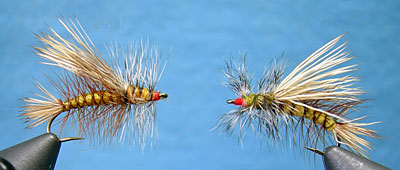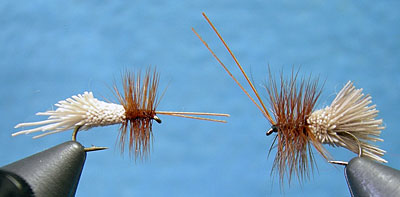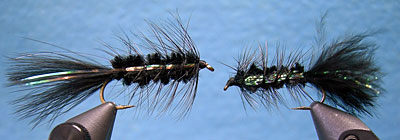Are Discount Flies a Good Deal?
Have a question you want answered? Email it to us at [email protected].
Question: I keep seeing ads for ridiculously cheap flies on the Internet. (The lowest I’ve seen is 54 cents per dry fly.) What’s the deal? Are they any good?
Alan R. Nutley, NJ

An Umpqua Feather Merchants Kaufmann’s Stimulator pattern on the left, and a less “spendy” version on the right. Note the poorly wrapped hackle, non-tapered abdomen, and inferior quality deer hair. Photo courtesy of Umpqua Feather Merchants.
Answer: Yet another front in the battle for customers between fly shops and online retailers is the market for fishing flies. A standard dry fly in a fly shop costs anywhere from $1.50 to $2.00, but there are literally dozens of online retailers who can offer patterns for half that price. Hot on the heels of Zach Matthews’s discussion of how fly-fishing products are priced, it makes sense to look at why certain flies cost more than others.
“Umpqua sells a spendy fly,” admits Bruce Olson, the company’s Fly Manager, but he argues that his products are worth every penny. In recent years, Olson has been buying flies from el-cheapo online retailers and comparing them to the Umpqua equivalents, and he has photographed them side-by-side to highlight the differences in quality. The photos shown here certainly display a sharp contrast.

Goddard Caddis: Note wrongly angled antennae on the discount fly (right), the poorly trimmed body, and the too-large hackle. Photo courtesy of Umpqua Feather Merchants.
“I don’t want to disparage any country or any particular factory,” he says, “but in order to produce flies that cheap, these guys have got to take shortcuts.” According to Olson, many of these companies use inferior hooks and materials, skip important tying steps (such as laying down a glue base on the hook shank to keep the materials in place), and don’t exhibit much quality control. He described one “Copper John” that he purchased online as missing the epoxy over the shellback and the lead under the thorax.
“So, you may have saved a lot of money on the fly, but it’s not a Copper John!” he says, and he notes that such an inferior version of the popular fly won’t perform on the water the way its designer intended. Without the lead, it won’t sink correctly, and the lack of epoxy makes the fly much less durable.
He argues that anglers should look at the cost of a fly in relation to its durability. If the 75-cent Stimulator in the picture here falls apart after the second fish, but the $1.75 Umpqua Stimulator is good for 10 fish, then the cost-effectiveness of the more expensive fly is twice as high. (75 divided by 2 fish=37.5 cents per fish, 175 divided by 10 fish=17.5 cents per fish.) “You gotta do the math,” says Olson.
Shawn Brillon, the fly buyer for Orvis, echoes many of Olson’s sentiments:
“Its all about quality, or better said lack thereof,” he says. “The first issue is that cheap imports always are tied on very cheap hooks, with strange sizing. I find that a quality fly has to be tied on [name brand] hooks. This becomes very important for big game, such as tarpon, where sharpness and tensile strength of the hook wire are vital.”
For Brillon, the low-cost company’s failure to use top-notch materials, adhere to standard pattern recipes, and ensure that every fly is perfect means the final product doesn’t measure up. “If you have to tie with junk, often the final product is the same … junk.”

Umpqua’s Flash-A-Bugger fly on the left and a discount version on the right. Note undersize hackle, the skimpiness of the chenille body and poor-quality marabou tail. Photo courtesy of Umpqua Feather Merchants.
Commercial fly tier Scott Sanchez, who has also worked with Dan Bailey’s and Jack Dennis fly shops, notes that it is possible to find good deals on the Internet, but that separating the good dealers from the hucksters is difficult:
“The Internet has changed the fly business, for good or bad. The good is that you can find some good prices, if you know what you are buying. The bad is that you won’t get advice on the flies and how and where to use them, and their quality is unknown. It is hard to qualify Internet flies. Some are very good, just overstocks, but some are not.”
Sanchez also highlights the ethical problems with buying online, noting that the better-known companies don’t run sweatshops.
“Most fly production is done in third world countries—surely for price, but also because they still work with their hands. I’ve been to factories in Colombia, and the women have solid middle-income jobs. In the factory that produces my flies in Bhutan, the head tier makes as much money as a doctor.”
Okay, so you’d expect the companies selling the high-end products to have nasty things to say about online discounters. I trolled a bunch of message boards where folks were discussing their experiences, which seem to run the gamut from extremely positive to downright disastrous. Many posters are completely satisfied with the quality of the flies they receive, while other anglers claim that the flies fell apart or didn’t look anything like the pictures on the Web site. All of which means that you’re taking a gamble ordering from these operations. Perhaps it’s a gamble you’re willing to take.
Strangely, the prices of even high-end flies have actually come down—in real dollars—over the last 20 years. Olson pulled out a rate sheet from 1992 and notes that Umpqua’s wholesale price for an Adams dry fly has gone up just 9% since then. The prices for Prince Nymph and Stimulator have gone down, by 9% and 4% respectively, over that time. Olson credits increased competition as the reason for the price reductions. When you consider the rate of inflation since 1992, you’re paying a heck of a lot less for those flies nowadays. And since you’ve spent a few hundred dollars on all your gear, why skimp on the thing that is most important to the actual fish? As Olson puts it, “The fish eat the fly, not the rod or reel!”











